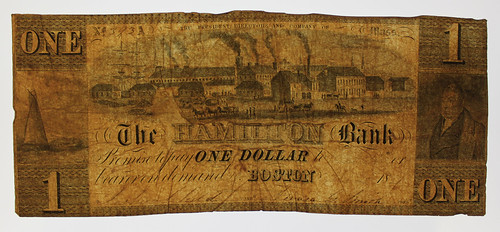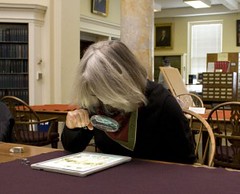
PREV ARTICLE
NEXT ARTICLE
FULL ISSUE
PREV FULL ISSUE
BOOK IN PROGRESS: COUNTERFEITER LYMAN PARKS (1788-1872)
The Past is Present blog from the American Antiquarian Society mentioned an upcoming book on counterfeiting by Deborah M. Child.
-Editor
Gilbert Stuart's bust portrait of George Washington continues to be a favorite subject for vignettes on American currency. Shown here is an example from the AAS currency collection.

This counterfeit bank note is an excellent illustration of what to look for when examining currency made before 1862 when the Federal Government began regulating the currency. Prior to that, each bank adopted its own distinctive design. Paper was not standardized and bank note plates were outsourced to private engravers. Internal control of currency was just as loosely maintained. Each note was individually numbered and then signed by the cashier and the bank president. Denominations for currency were not standardized either and could range from five and half cents to 10,000 dollars. All these variations provided a myriad of opportunities for the counterfeiters aka koniackers to ply their trade.

The bank for which it was originally printed was undoubtedly defunct so the counterfeiter removed the name of the original bank and substituted this name to place it back in circulation. Not surprisingly, all this devious behavior corrupting the currency prompted a public outcry and a proliferation of anti-counterfeit guidebooks and newspapers. Trouble was the counterfeiters would study these guides as closely as the bankers and adjusted their practices accordingly.
To read the complete article, see:
Fraud Week, Part 3: Funny Money
(pastispresent.org/2011/good-sources/ THE BOOK BAZARREWayne Homren, Editor The Numismatic Bibliomania Society is a non-profit organization promoting numismatic literature. See our web site at coinbooks.org. To submit items for publication in The E-Sylum, write to the Editor at this address: whomren@gmail.com To subscribe go to: https://my.binhost.com/lists/listinfo/esylum All Rights Reserved. NBS Home Page Contact the NBS webmaster 
|

